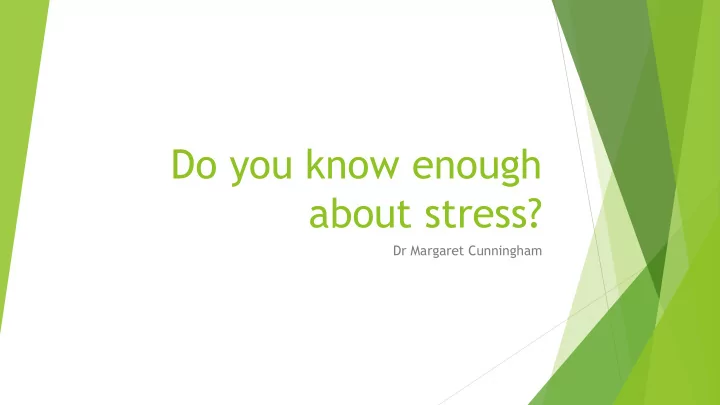

Do you know enough about stress? Dr Margaret Cunningham
Work Stress… The process by which workplace psychological experiences and demands (stressors) produce both short-term (strains) and long-term changes in mental and physical health.
Transtheoretical Theory of Stress
Physiology of the stress process
Common signs of stress Psychological symptoms: Emotional exhaustion, burnout, worry, panic attacks, feeling on edge, anger, poor concentration, unable to switch off, feeling worthless, feeling hopeless, irritable Behavioural symptoms: Sleep disturbance, tearful, drinking too much, appetite loss Physical symptoms: Backache, headache, eye strain, dizziness, fatigue, gastrointestinal problems
Economic Impact of Stress HSE (2012/13) – Self reported stress, depression or anxiety caused by or made worse by work – 428,000 people 10.4 million working days were lost to stress, depression or anxiety CIPD (2014) Absence Management report – Stress is a common cause of absence – 75% public sector organisations ranked stress in top 5 reasons for absence Two-fifths of organisations report an increase in stress-related absence over the past year Main causes of stress at work - workloads/volume of work, management style, relationships at work, considerable organisational change/restructuring, pressure to meet targets.
Work stressors Associated with physical symptoms: Interpersonal conflict, lack of control, organisational constraints, role ambiguity, role conflict, work hours and work load. Associated with psychological symptoms: Role clarity, role conflict, role stress, stressful events, workload and work pressure. Job insecurity, supervisor and co-worker aggression are more strongly related to psychological symptoms than physical symptoms.
Challenging stress vs stress as a threat Challenging stressor – holds the possibility for mastery or benefit Opportunities for personal growth (e.g. workload) Hindrance stressor – contains the possibility of harm or loss Obstacles to personal growth (e.g. role ambiguity and role conflict)
Hindrance stressors Stressors which are unlikely to be overcome by the employee, even with extra effort situational constraints, hassles, role ambiguity, role and interpersonal conflict, role overload, supervisor-related stress, organisational politics, and concerns about job security Lead to low job satisfaction and high turnover intentions Negatively associated with job performance Demotivating – the effort expended to cope with these stressors is unlikely to be successful Associated with greater use of emotion-focused coping e.g. distraction, avoidance, emotional disclosure, eating more, drinking alcohol, taking medication.
Challenge Stressors Demands or obstacles that can be overcome with extra effort to result in the accomplishment of goals and the potential for personal development. high workload, time pressure, job scope, and high responsibility Positively associated with job satisfaction, task performance, engagement, creativity and productive behaviour Motivational - because individuals are likely to believe that there is a positive relationship between effort and performance Associated with greater use of task-focused coping strategies which focus on addressing the demand.
Hindrance Stressors and Safety Hindrance stressors lead to lower levels of safety compliance and safety participation. Hindrance stressors are associated with increased frequency of near-misses and occupational injuries. Safety behaviours mediate the effect of hindrance stressors on injuries and near-misses. Important to manage the sources and effects of hindrance stressors effectively as a means of preventing unsafe behaviour and injuries. (Clarke, 2012)
Challenge Stressors and Safety Negative association between challenge stressors and safety participation. Suggests that although employees may be able to maintain safety compliance in the face of challenging situations, they may respond to these sources of pressure by withdrawing effort to participate in safety-related activities. Challenge stressors were associated with near misses, but not occupational injuries. Suggests that the experienced strain associated with challenge stressors leads to greater vulnerability to errors and cognitive failures (which increase the likelihood of near-misses), but that increased attentiveness may allow individuals to recover those errors before they lead to accidents and actual physical harm. (Clarke, 2012)
Transactional Model : Stress Management
HSE Stress Management Standards
Dr Margaret Cunningham margaretcunningham39@gmail.com
Recommend
More recommend